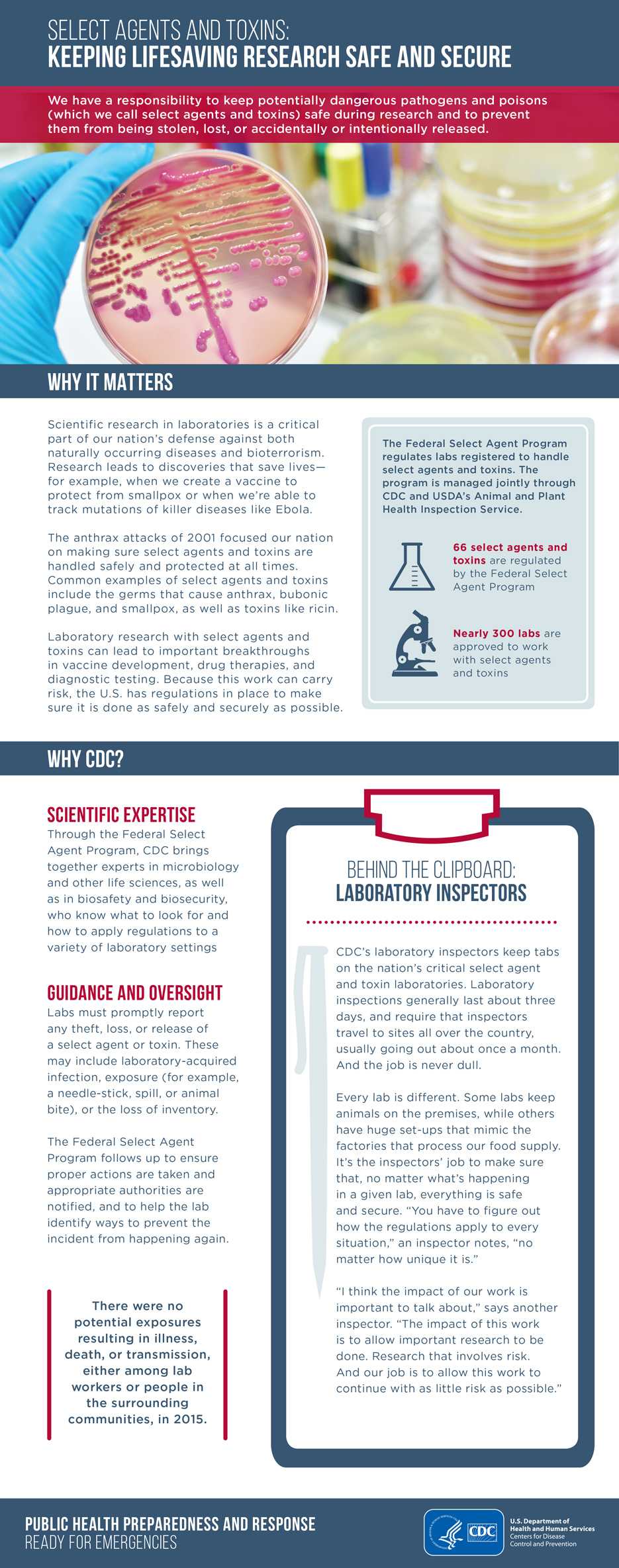Select Agents and Toxins: Keeping Lifesaving Research Safe and Secure
Text Equivalent
Select Agents and Toxins: Keeping Lifesaving Research Safe and Secure
We have a responsibility to keep potentially dangerous pathogens and poisons (which we call select agents and toxins) safe during research and to prevent them from being stolen, lost, or accidentally or intentionally released.
Why It Matters
Scientific research in laboratories is a critical part of our nation’s defense against both naturally occurring diseases and bioterrorism. Research leads to discoveries that save lives— for example, when we create a vaccine to protect from smallpox or when we’re able to track mutations of killer diseases like Ebola.
The anthrax attacks of 2001 focused our nation on making sure select agents and toxins are handled safely and protected at all times. Common examples of select agents and toxins include the germs that cause anthrax, bubonic plague, and smallpox, as well as toxins like ricin.
Laboratory research with select agents and toxins can lead to important breakthroughs in vaccine development, drug therapies, and diagnostic testing. Because this work can carry risk, the U.S. has regulations in place to make sure it is done as safely and securely as possible.
[TEXT BOX]
The Federal Select Agent Program regulates labs registered to handle select agents and toxins. The program is managed jointly through CDC and USDA’s Animal and Plant Health Inspection Service.
- 66 select agents and toxins are regulated by the Federal Select Agent Program
- Nearly 300 labs are approved to work with select agents and toxins
Why CDC?
Scientific Expertise
Through the Federal Select Agent Program, CDC brings together experts in microbiology and other life sciences, as well as in biosafety and biosecurity, who know what to look for and how to apply regulations to a variety of laboratory settings.
Guidance and Oversight
Labs must promptly report any theft, loss, or release of a select agent or toxin. These may include laboratory-acquired infection, exposure (for example, a needle-stick, spill, or animal bite), or the loss of inventory.
The Federal Select Agent Program follows up to ensure proper actions are taken and appropriate authorities are notified, and to help the lab identify ways to prevent the incident from happening again.
Behind the Clipboard: Laboratory Inspectors
CDC’s laboratory inspectors keep tabs on the nation’s critical select agent and toxin laboratories. Laboratory inspections generally last about three days, and require that inspectors travel to sites all over the country, usually going out about once a month. And the job is never dull.
Every lab is different. Some labs keep animals on the premises, while others have huge set-ups that mimic the factories that process our food supply. It’s the inspectors’ job to make sure that, no matter what’s happening in a given lab, everything is safe and secure. “You have to figure out how the regulations apply to every situation,” an inspector notes, “no matter how unique it is.”
“I think the impact of our work is important to talk about,” says another inspector. “The impact of this work is to allow important research to be done. Research that involves risk. And our job is to allow this work to continue with as little risk as possible.”
[TEXT BOX]
There were no potential exposures resulting in illness, death, or transmission, either among lab workers or people in the surrounding communities, in 2015.
- Page last reviewed: April 3, 2017
- Page last updated: April 3, 2017
- Content source:


 ShareCompartir
ShareCompartir
